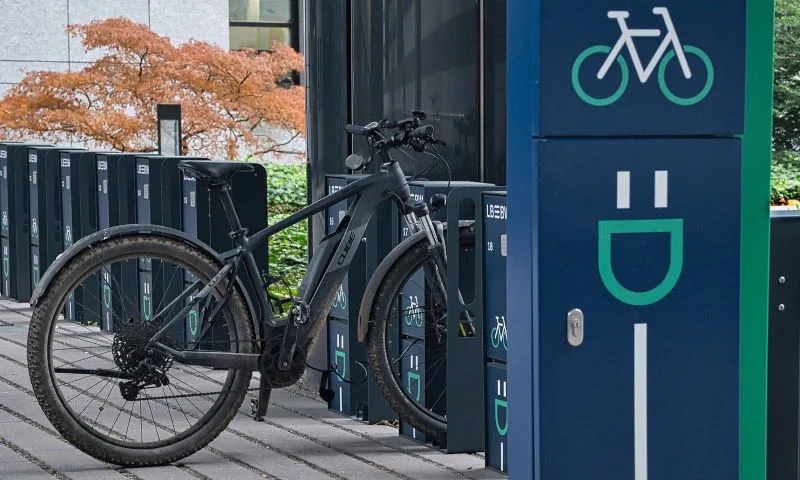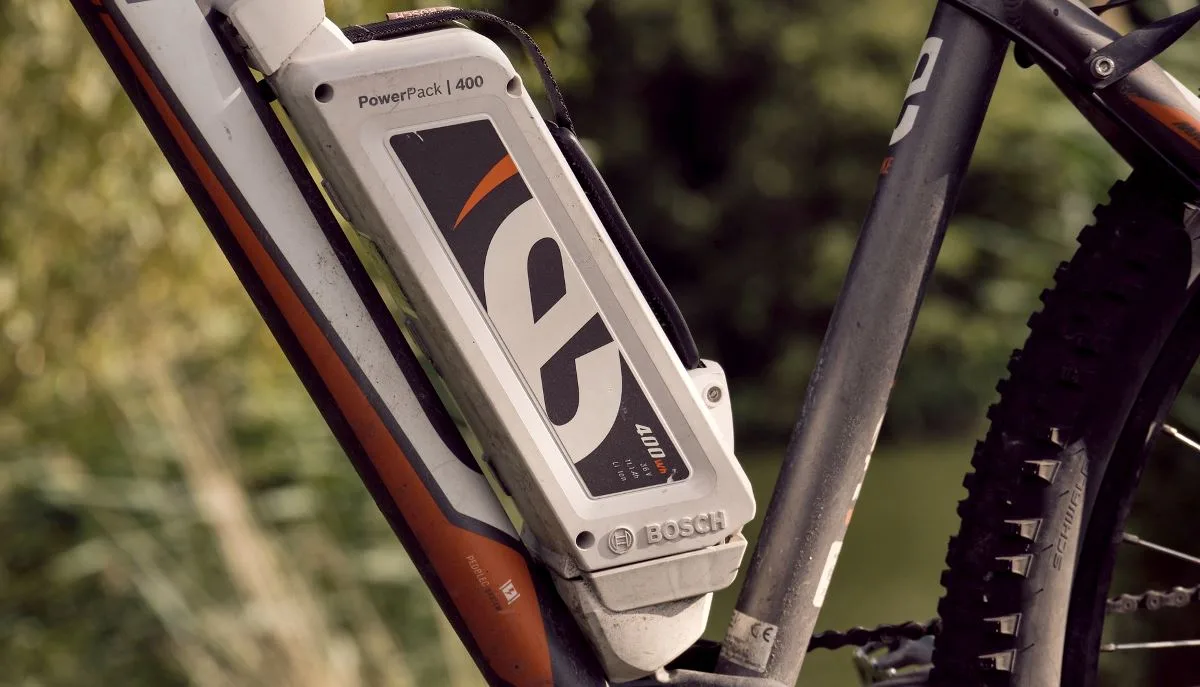Electric bike batteries are probably the most important part of your ride. Knowing how far you can go and how much you can push the bike will make a massive difference. Read on for everything you need to know about e-bike batteries.
The job of an electric bike battery is simple – they provide power for the motor to turn the wheels. They also provide power for any gadgets you have like the controller or “brain” that measures speed and pedaling to figure out how much extra power you need.
The battery is the key bit of technology for e-bikes that makes them possible. We’ve had electric motors small enough but only recently have batteries become small, light, and stable enough to help cyclists without big downsides.
What To Look For In Electric Bike Batteries?
An electric bike battery needs to be:
- Small enough to fit on a bike frame and not cause drag
- Light enough that it adds power and doesn’t take it away
- Rechargeable in a reasonable amount of time
- Lasts as many recharge cycles as possible
- Resistant to rain, sudden shock, or puncture
- Works at a good range of temperatures
All modern-day electric bike batteries that are Lithium-Ion (Li-ion) and made in the past few years will have all of these properties. Though Li-ion batteries need an intelligent charger and a plan for charging and discharging, they are much better all-rounders for our purposes.
From 2021 onward we don’t recommend buying anything other than a Lithium-Ion e-bike battery.
The important things for you to look for depending on if you are buying a new e-bike, converting a normal bike to an e-bike with a kit, or replacing a battery for your current e-bike. However, the following simple tips should help
1 – Ignore Range – Calculate Watt Hours Yourself
Manufacturers make many claims about range based on very tight and specific “testing” they do. As the testing standards vary hugely between brands there isn’t much point in listening. The important figure to look for is Watt-Hours, also written as Wh.
Instead of comparing the range given by brands you should calculate the Watt Hours yourself. This will give you a more even comparison between batteries.
Watt-Hours means how many Watts of power the battery can provide at full power for one hour. Meaning a 720 Wh battery could give a full 720 Watts of power for a full hour – or at half power could give 360 Watts of power for half an hour.
The simplest way is to times the Voltage (V) of the battery by the Amp Hours (Ah). So a 48 V battery with a 15 Ah rating would be 720Wh. A 72 V battery with a 10Ah rating would also be 720Wh.
2 – Stick To Branded Cells
E-bike batteries are made of individual cells that are normally Li-Ion 18650. It’s always worth sticking to name brand cells known as the big 5 – Samsung, Panasonic, Sony, LG, or Sanyo. Cook battery and bike sellers will note what brand cells they use on the battery, ask if they don’t

They’re more expensive but they have much higher quality control and you will be getting what is advertised. Cheaper cell makers might lie and you’ll more often get complete duds or cells that lose charge faster.
3 – Go bigger than you think you’ll need
There are a lot of different calculations you can do to figure out how much power you’ll use, how efficient the bike and motor are, how cold will affect the battery e.t.c. All electric bike classes in the US are limited to 750W of motor power.
The biggest problem is that if you ever do run out of battery at the wrong spot you could have a hard time getting where you need. It’s always going to be worth spending a little bit more on a better battery or bike/battery combo.
In the short term, you won’t worry as much about hills or longer rides. Long term you’ll be less likely to have to replace the battery early. Fewer charges and fewer empty to full charges will make the battery last longer.
How Much Power Does An Electric Bike Use?
How much exactly depends on quite a few factors, including:
- Motor power and efficiency
- Battery type and quality
- What level of pedal assist you use
- How intelligent the e-bike controller is
- Weight of the bike and the rider
- Wind speed and direction
- Angle of the ride – Hills or flat
- Surface – Flat paved or sand/off-road
- Heat – both weather and of the battery itself
Do Throttle Electric Bikes Use More Power Than Pedal Assist?
Yes. An electric bike using throttle only will use more power than a pedal assist, so if you have both it’s best to stick to pedal assist. Using the assist at the lowest setting you are comfortable with will make the battery last much longer too.
When you use a throttle on an e-bike the motor is doing all the work and requires a good amount of power. When you assist by pedaling you’ll be doing some of that work. The initial acceleration takes more power too so if the power doesn’t kick in straight away that’s a big help for saving the battery.
Electric Bike Battery Jargon Explained
The most important thing to look for when comparing electric bikes is the Watt Hours (Wh) and Watts (W).
W – Watts or Wattage
Wattage is the overall power of an electrical system. Wattage is calculated as Volts multiplied by Amps. Simply put W = V x A. So a 48V battery running at 15 Amps produces 720 Watts of power.
Batteries are measured in Watts so if you’re deciding between two batteries on a new bike – the higher will last longer.
Wh – Watt Hours
Watt-Hours measures the power than can be delivered in watts per hour.
It’s measured by taking dividing the total Watts of the battery by the peak power your electric bike uses. So an 800W battery would power a 400W motor continuously for 2 hours. 800W / 400W = 2Wh.
V – Volts or Voltage
Voltage is the power or force that the battery can deliver. For e-bikes, the battery (and motor) voltage will be in 12 Volt increments like 36V or 48V. Think raw power with the higher being more powerful.
Different Voltage batteries probably won’t work with different e-bikes or controllers. Check the connectors and motor/controller power before buying or swapping.
A – Amps or Amperage
Amperage measures how much electricity can pass at a time. It’s normally the controller and motor that are rated for amps to show how much power they can deliver
Battery Capacity – 400Wh, 650Wh, 700Wh & Higher
The bigger the battery capacity the longer you’ll be able to ride. Many modern e-bikes come with 650-700W (Watt) capacity as standard for a better range. A larger battery capacity also means a physically bigger and heavier battery.
If a battery is meant for a specific voltage e-bike motor or specific model then the battery will also have a Watt Hour (Wh) rating. See the jargon section for an explanation.
With electric mountain bikes or road e-bikes, the capacity tends to be a little smaller because weight greatly affects the ride and speed. A commuter e-bike or one more suited for easier cruises might have a larger battery as it aims for a better range.
Related – Are Electric Bikes Waterproof?
Find out How much does an Electric Bike weigh?
Our expert chooses the Best Electric Bike For The Money
Battery Voltage – 36V, 48V, 52V?
This is less clear cut than many people think but in general, a higher voltage battery will perform better. That’s mainly because higher voltage means more individual cells, meaning in theory less load on each cell but higher overall output.
However, if you’ll just use go faster, you draw more power and this doesn’t make a difference. Consider a higher voltage if you’ve tested a bike (or have one already) and find you want more power on hills, more acceleration, or a longer range.
The voltage of electric bike batteries is measured by multiplying the number of individual cells in the battery by the output in voltage of each cell. As e-bikes generally use 18650 cells that output around 3.6V this is how we calculate the overall voltage.
For example, a 36V battery is made up of ten 3.6 Volt cells. 10 x 3.6 = 36V. Easy! What about a 48V battery? Well, that would be thirteen cells, making 13 x 3.6 = 46.8V. Isn’t that a little off?
Well, this is because the 18650 cell output is actually not exact as it changes from higher when it’s full, to lower when getting empty. At full charge an 18650 cell can output up to 4.15V safely and go down to around 2.8V to 3V at its lowest before losing cycle life.
To make the naming conventions more consistent, battery makers use an output of 3.7 Volts instead (even though they’re the same cells). So 13 x 3.7 = 48.1V. That makes 48V rounded – good enough!
You can also get 52V batteries which is just one extra cell than 48V ones – 14 x 3.7 = 51.8V – basically there and sometimes called 50V. They aren’t a huge upgrade if you’re considering one vs a 48V. 72V is less common and is 20 cells, double the 36V battery. 20 x 3.6 = 72V.
Max Peak & Continuous Current Rating
E-Bike batteries come with two different current ratings. These are really important to note if you are buying a new e-bike or replacing a battery.
The max peak current rating of an electric bike battery means the highest peak current in Amps that the battery can take. It can’t sustain this draw for long but can take it in bursts.
For example when you first accelerate up to top power the motor may draw up to the peak to get up to speed but can’t continue drawing this much power for long. It’s sometimes called a burst rating and should normally be used for a couple of seconds maximum.
The continuous current rating of an electric bike battery is the highest continuous draw the battery can handle in Amps. This means that the battery should be able to draw power at this rating non-stop until the battery is drained.
So if the max peak might be used for the initial acceleration to top speed and the continuous peak keeps you at that top speed. Think about going full throttle on a long road until the bike dies.
What Are Electric Bike Batteries Made Of?
An electric bike battery is made up of a collection of smaller battery cells wired together with a few safety measures to stop discharges of fire. They are then normally packaged up in a weather-proof container called a shell, case, or box that’s removable and has an easy way to plug in and charge.
There are a few technologies used in e-bike batteries but the most popular is Lithium-Ion or Li-Ion. It’s the same technology used in mobile phones and most modern tech.
The cells that make up the larger battery will normally be made up of Li-Ion 18650 cells which are named for their size – 18mm wide by 65mm high, 0 for the cylinder shape. They’re a popular cell because of the versatility of this size and good output.
Electric Bike Battery Charging
As with all batteries, your e-bike batteries will need charging. Most aren’t as simple as a USB port charger like with phones and will come with their own charger system that will plug into a wall socket. Different brand chargers and batteries don’t often work with each other.
Charging speed depends on the battery size, wattage, and charger speed. Charging an electric bike battery takes from around 3 to 6 hours from 0 to 100%. You can get faster chargers that take 1-2 hours. However, fast charging a lot isn’t healthy for the battery.
Chargers are normally measured in Amps. The higher the Amps the faster your battery will charge. Chargers are around 3-5 Amps but charging at the highest/fastest setting all the tie isn’t recommended.

If you will be using your e-bike regularly you’ll need to have somewhere you can plug your bike in and leave it to charge overnight. If you use an electric mountain bike you may need extra batteries or a more portable charger for quick charges in between runs.
Bear in mind that chargers are rated in volts and should be matched to the battery’s voltage. So a 36V charger might not work if you upgrade from a 36V to a 48V battery. Keep this in mind if you’d like a bike to last a long time and expect to replace and upgrade a battery in the future.
Removable Batteries Or Built-In
Most batteries on e-bikes are easily removable so you can just take the battery off and charge it where it’s convenient. Some high-end e-bikes built for cities, or electric mountain bikes, have the battery built into the down tube.
Having an internal battery can help to stop the theft of the battery but will mean you’ll need a space in a garage or bike rack to charge it. Another advantage of a built-in battery means the bike can be a stealth e-bike and people won’t know its worth, or you can get away with an e-bike where they might not be wanted.

Here are three different styles of batteries for e-bikes. The first is the classic removable shell mounted on the outside of the bike. The middle is a purpose-built battery mounted in the bike’s frames but still removable. The third is an internal, non-removable battery.
Find out why we always recommend keeping your E-Bike indoors – Can You Leave An Electric Bike Outside?
Electric Bike Battery Brands
The individual cells of a battery are made by many different companies. There are plenty of different brands out there at different prices. The general advice is to stick to known brands like Samsung, Panasonic, Sony, LG, and Sanyo.
This isn’t because the cells are necessarily the best but because quality control and consistency are better. With cheaper brands, a few cells of the battery might be less efficient than others and more likely to fail earlier.
This will end up with dead or almost useless cells in a battery which will overall reduce the power output. This in turn makes the other cells work harder, shortening their life and reducing the overall power available.
